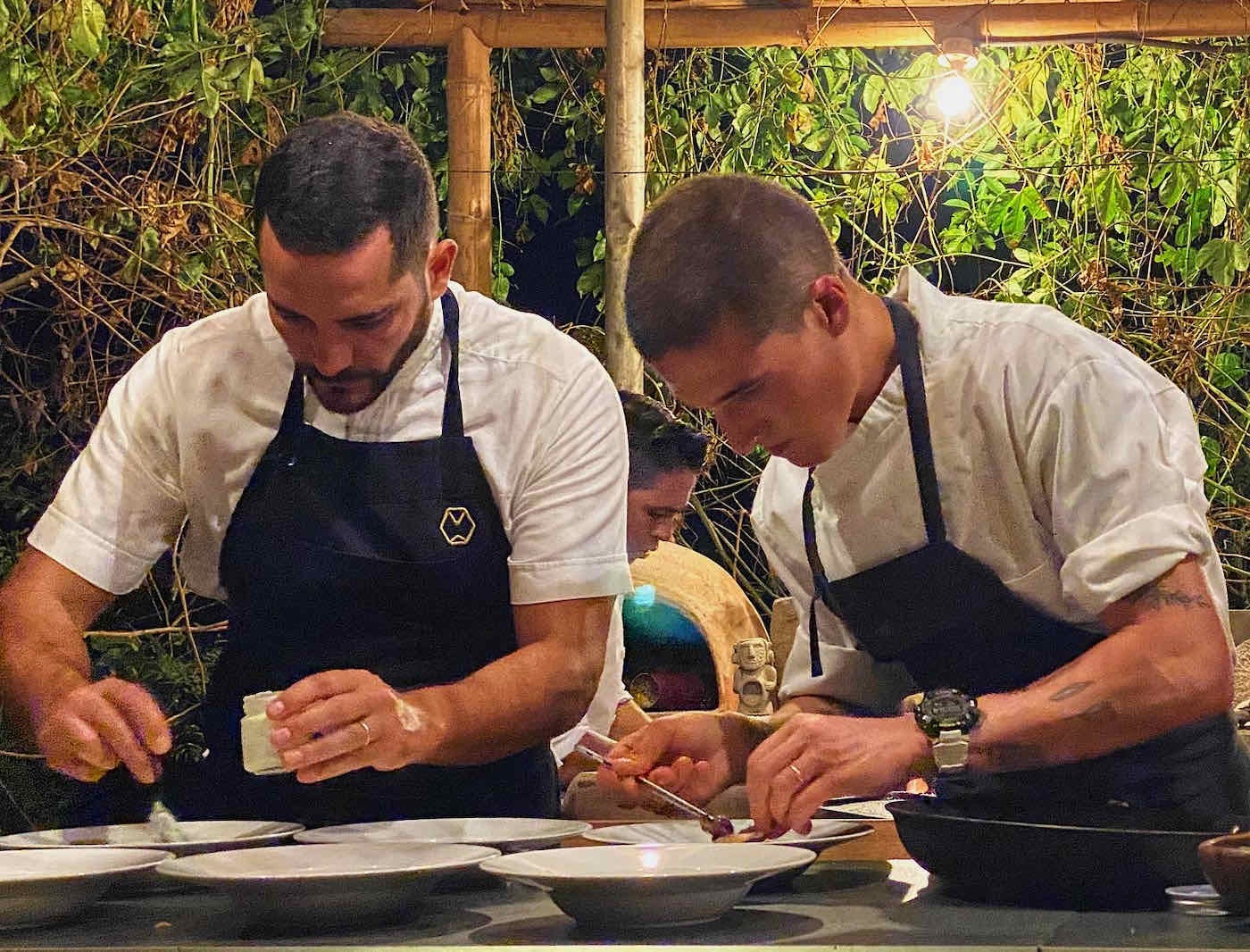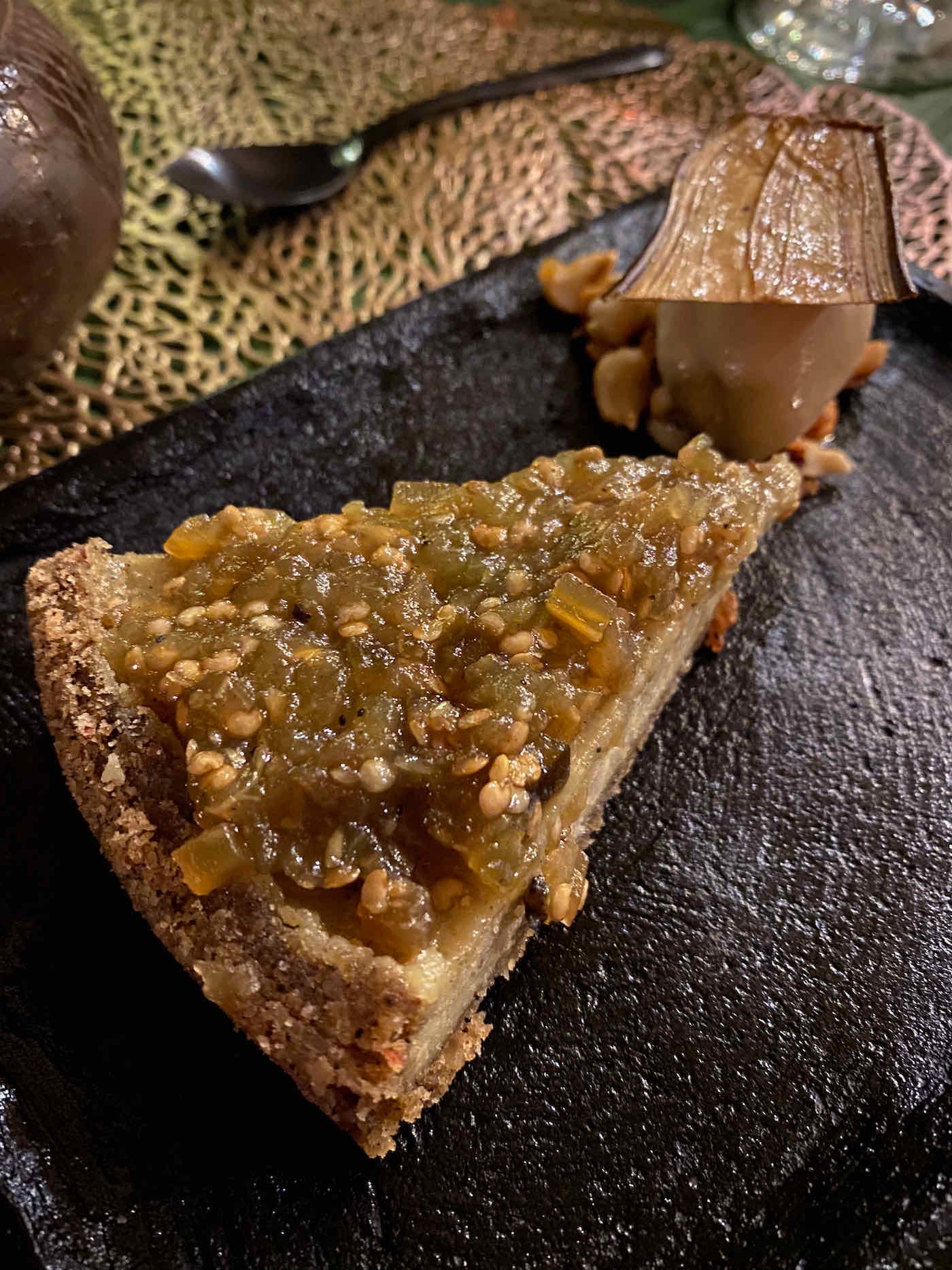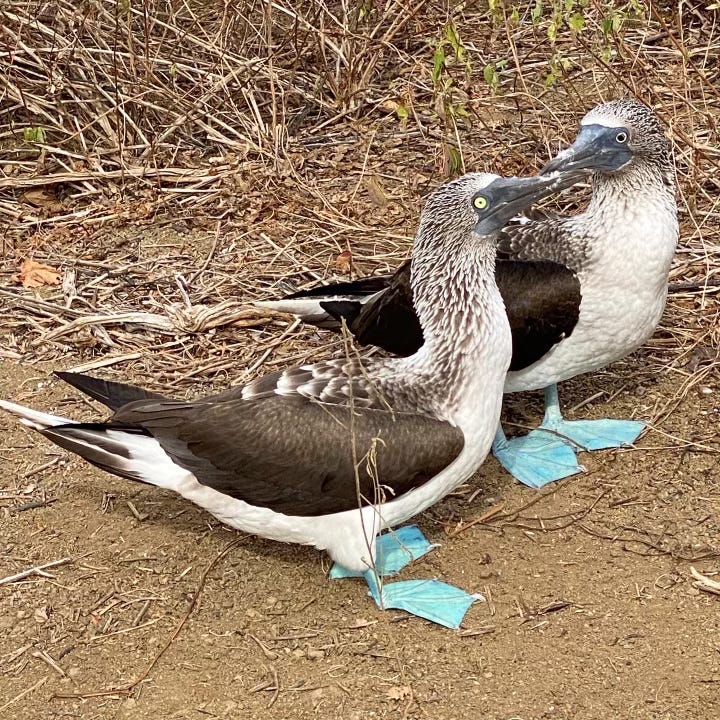For the Beauty of the Earth
Some fragmented thoughts on sacred architecture, the chef Rodrigo Pacheco and how we honor history, the land, and one another through what we eat and cook
Thursday, May 19
Manabí Province, Ecuador
Hola, kind reader.
When I’m traveling on assignment, the whirl of activity and the worry of getting enough material often overwhelms my ability to write. But today, I’m sitting about a hundred yards from the roaring Pacific Ocean—the best ocean, in the opinion of this California native—and I’ve got a few hours to scribble some notes to you.
I landed in Quito late last Friday night, after an all-day, three-flight journey from Grand Rapids. The next morning, I took a brief tour of Quito’s old town, which in 1978 was named one of the inaugural World Heritage Sites by Unesco. I’m an unashamed church geek, so of course one highlight for me was the Basilica of the National Vow, a Neo-Gothic giant that rises in the heart of the old town. Designed by the French architect Emilio Tarlier in the 1890s, the church is said to have been inspired by Notre-Dame Cathedral in Paris.
The details I loved most about the basilica were the ones that subtly but significantly told a story about this land. On the exterior, instead of the monstrous gargoyles you’d find on your typical Gothic construction, Tarlier chose animals from across Ecuador—tortoises and tapirs, iguanas and condors. Inside, I climbed to the choir loft for a close-up look at the huge rose window on the basilica’s southwest facade. The design features some 300 varieties of native orchid, a picture of the tremendous biodiversity in the country.
Later that day, I flew to Manta, the largest city in Manabí Province, and made the hourlong drive southwest to visit chef Rodrigo Pacheco. I wrote about Pacheco briefly for Travel+Leisure’s 2022 Global Vision Awards, but I hadn’t had the opportunity to taste his food. (Some of you might also recognize Pacheco from the 2018 Netflix series The Final Table.)
Nearly a decade ago, Pacheco and his wife, Dayra Reyes, took over an old pepper farm near the ocean. After years of agricultural overuse, the soil had degraded. Pacheco set about restoring it, with the aim of creating what he calls an “edible forest.” He slowly built his relationships not just with the land and all that grows on it but also with local people, learning from them about traditional Indigenous cooking techniques and foodways. Several years later, he opened BocaValdivia—“boca,” which is Spanish for “mouth,” plus Valdivia, to honor the Indigenous culture that thrived in this region in precolonial times.
BocaValdivia is an open-air restaurant set in a clearing in Pacheco’s edible forest. My table offered a direct view of the outdoor kitchen, where Pacheco and his team cook over an open wood fire on a traditional Manabí cooktop—a versatile volcanic-rock construction with multiple semi-spherical indentations that can be used to bake, steam, and roast. Adjacent to this space, there’s an indoor kitchen, “where we have all the modern technology,” Pacheco said. But it’s more stripped-down than your typical high-end restaurant kitchen. He doesn’t need as many refrigerators because his surroundings serve as a built-in pantry and he prefers just to harvest what he needs for that day: “The forest,” he said, “holds my food.”
Nearly all of what goes into Pacheco’s dishes is farmed, foraged, or fished nearby. He is strict about what he serves, and not all that could be labeled “local” passes muster; you won’t find tuna on his menu, for instance, even though you can find it in the waters off Manabí, because he’s worried about the sustainability of the fishery. Instead, he prefers fish like dorado (also known as mahi-mahi), which he delivered in the form of the most luxurious bar snack I’ve ever had. A small bowl contained four slices of fish, two seared and two cured, atop what he calls “earth’s caviar“—a mix of quinoa and black amaranth, spiced with smoked ají pepper—along with slivers of cured egg yolk.
The astonishing tasting menu that followed was a tour of the region’s rich bounty, refracted through the lens of Pacheco’s French training (he studied at the Institut Paul Bocuse in Lyon) and reimagined through his mad-scientist mind: sea urchin with artichoke, mint sorbet, and a peanut cracker; grilled langoustine with native corn, zucchini, and a bright herb pistou; sautéed calamari, a beautifully earthy black-corn humita, beet gribiche, and some deep-fried tentacles for crunch; smoked duck with a fat, raw reef oyster, wild mushrooms, a manioc blini, and a palo santo-infused emulsion; and a compressed rectangle of suckling-pig meat with a mille-feuille of several varieties of heirloom potato, a chimichurri made from a medicinal bitter herb called ruda, and a condiment of smoked banana.
I loved every dish. But love can come in different forms. Sometimes it’s a sigh of satisfaction. Sometimes it means you slow down so as to extend enjoyment. Sometimes it expresses itself in curiosity; it says, “I want to understand you better.”
The most startling dish was a dessert—cheesecake topped with eggplant that had been cooked slowly with brown sugar, served with a quenelle of coffee ice cream. When I asked Pacheco how he’d decided that eggplant, typically a savory ingredient, would work in a sweet treatment, he said that the idea came to him in the garden. “We have so many eggplants! Sometimes in the garden, they’re neighbor to papaya, sometimes to a coffee tree. If they’re neighbors in the garden, why not on the menu?” he mused. I’m still thinking about the dish, not because it didn’t work but because it did, messing mischievously with the boxes in which I put familiar ingredients. The eggplant was soft, creamy, almost custardy, and with the brown sugar’s complexity melted in, it made a convincing case that it had always been destined for dessert.
BocaValdivia is small. This is intentional. The night I ate there, he had just one seating and six guests—a Costa Rican/Ecuadorian family of four; his cousin Majo, who works at the U.S. Embassy in Quito; and me. “I would rather cook for two people and look them in the eye than cook for 300 whom I never have the chance to touch base with,” he said. He also acknowledges that not everyone will get his food, and he’s okay with that. Pacheco’s cousin told me that much of their own family would find the food overly fussy and unfamiliar. Pacheco added that his own father “is more traditional” and often doesn’t understand what his son cooks.
When I asked how it feels when his food puzzles people, Pacheco shrugged. “I’m not afraid,” he said. Next month, he will open a new restaurant, Foresta, in Quito, which will be able to reach many more people than can make the trip to BocaValdivia. A couple of the dishes I tried, including the duck, will feature on Foresta’s menu, which will be overseen by the Argentinian chef Jeronimo Bosch Cook, who was working alongside Pacheco at BocaValdivia that night. “Whoever is willing to try my food, if they don’t like it, they can just go to another restaurant,” Pacheco said. “There are many other restaurants.”
In the days since I dined at BocaValdivia, I’ve been thinking about the multiple layers of meaning in a meal—both for those who prepare it as well as for those who partake.
Pacheco tries simultaneously to celebrate the rich, complex heritage of the country he loves and to shape its future. On the hectares under his stewardship, he’s fostering healthy biodiversity and imagining new ways to honor the land’s bounty. Then there’s his team. As we chatted after dinner, he told me that he’s as interested in cultivating human talent as he is in growing excellent ingredients. Nearly all of his employees come from local Indigenous communities. Few finished even primary school. To work in BocaValdivia’s kitchen represents education and possibility—and not just for them. Recently, Pacheco met a man named Cesar who needed work. He realized that Cesar was a ceramicist gifted in traditional techniques. So he hired him. Cesar now crafts dishes and serving vessels for BocaValdivia. “The important thing is that, more than a restaurant, this is a learning experience,” Pacheco said—for him, for his staff, and for his guests.
To try new flavors and dishes is to make new memories. It might be something you’ve never had before, like the shot of currincho, a liquor distilled from fermented sugarcane, which he thrust into my hand at the evening’s end. Or it might be a familiar ingredient reimagined as the eggplant was; I can’t imagine that I will ever eat eggplant again without thinking of that cheesecake.
Beyond the plate and the palate, Pacheco wants his guests to think more deeply about our ecosystems. If they leave with expanded curiosity and renewed care for good ingredients as well as the soil and the seas from which they came, he has done his job. If they, too, wish to help restore more hectares, all the better.
It strikes me that what Pacheco ultimately wants is to heal what’s been broken in a world that blithely consumes. And though he never said it outright, I suspect that what drives him is passionate gratitude—for his country, for its culture, and for all of life’s abundance that is represented at the table.
At one point, he waxed philosophical about the ancient role of a shaman. “Shamans used to play an essential role in so many communities,” he said. They pointed their people upward, to the movements of the sun, moon, and stars; down, to the cycles of the earth beneath our feet; and beyond, to matters of faith and mystery. In times of suffering and sickness, they sought to soothe and, if possible, to cure, concocting tinctures, potions, and balms. At moments of import, they fostered belonging, presiding over rituals of initiation and rites of passage.
Pacheco lamented that, in our rational world, the shaman has so often been reduced to a figure of superstition. What if, he mused, a chef could be considered something of a shaman too? To prepare a meal—on Pacheco’s level, sure, but even just as an intentional home cook—and to participate in one can indeed point people beyond themselves, helping to heal our relationships with one another and with the world around us. It really doesn’t matter if it’s an elaborate tasting menu or a simple one-pot dinner. If we cooked and ate so thoughtfully, we might end more meals full not just in our stomachs but also, perhaps, in our hearts.
Do I overthink my food? Yes, absolutely I do. It gives me delight. Also delightful: hearing from you. What meals do you recall that have stirred your curiosity and fed your soul? What foods have nourished not just your bodies but also your spirits and expanded your sense of care and respect for others—other people and other cultures?
I begin the long journey home to Michigan tonight. If you ever have a chance to visit Ecuador, please take it. Yes, I’ve been reminded that my one year of high-school Spanish left me with language skills that are utterly no bueno—sorry, Señora Fraser. Yet the hospitality of this land has wowed me, as has its stunning and diverse beauty.
As ever, thank you for reading my words. I’m so grateful that we can stumble through all this together, and I’ll try to write again soon.
Hasta la próxima,
Jeff








I identify with your delight in food. My happiest memories almost always include food, and whenever I'm asked to list things I'm grateful for at any particular moment, a recent meal is always on the list. My husband and I keep a running list of meals that were true experiences, thus indelibly shaping us. One of my favorites was at a WWII bunker-turned restaurant on a tiny side street in Klaipèda, Lithuania, a port town that was at that moment in the middle of its annual Sea Festival. While we ate lamb dumplings and cherry dumplings with a refresher of horseradish-infused vodka, the cool Baltic Sea breezes wafted over our sun-soaked sidewalk bench. Then, to our surprise, a parade started up from somewhere else in the city and marched by, trumpets blaring and balloons and flags flying. A friend who was with us that day remarked that it was a moment to make one "happy in the deep places." We still use that phrase when we're feeling the joy from food, good company, and pleasant surroundings.
As someone with an autoimmune disease and who has made a substantial diet change as a result, it was a wonderful experience for me to read of how food is being treated with such intention and gratitude (and dare I say even reverence?). Because I have to think about what I eat, I am a lot more aware of "thoughtless" eating than I was before.
Also, your words about love taking on different forms stopped me in my tracks. You were writing in the context of food, but it hit me that this is also a way to approach relationships. I needed that just now; thank you Jeff!